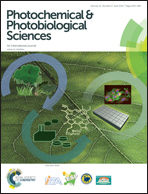A study of the Fenton-mediated oxidation of methylene blue–cucurbit[n]uril complexes†
Abstract
Cucurbit[n]urils efficiently decreased the Fenton-mediated oxidation of encapsulated dyes, providing a mechanism for some control and selectivity over the degradation. The encapsulation of methylene blue into cucurbit[7]uril made it highly refractory against Fenton oxidation in the dark or under UVA light irradiation. However, the oxidation of the encapsulated dye was significantly enhanced under visible light irradiation. This behavior was selective for the cucurbit[7]uril complex and not for the cucurbit[8]uril complex, which achieved the same degree of protection irrespective of the irradiation conditions. This different reactivity of the complexes was further discussed in terms of their excited state properties. The main mechanism for protection was the seclusion of the dye into cucurbit[n]urils as shown by the fact that the non-encapsulated dye safranin was protected much less than methylene blue. Additionally, cucurbit[n]urils efficiently trapped hydroxyl radicals, which contributed significantly to the protection of the dyes from Fenton-mediated oxidation.
![Graphical abstract: A study of the Fenton-mediated oxidation of methylene blue–cucurbit[n]uril complexes](/en/Image/Get?imageInfo.ImageType=GA&imageInfo.ImageIdentifier.ManuscriptID=C4PP00362D&imageInfo.ImageIdentifier.Year=2015)

 Please wait while we load your content...
Please wait while we load your content...